Lolita in the Dominican Republic
Editorial Comment
A valuable illustration of racist manipulation by the news may be found in the first article below.
It describes two major scandals: the prevalence of pedophilia in Dominican society and the routine performance of unnecessary Caesarian sections. Specifically, 58 percent of births are to adolescent girls, and 40 percent of births are by C-section. These are barely noted and are certainly not qualified as being scandalous. Of all Latin American and Caribbean countries, the DR is the one with the highest percentage of pregnant adolescents. No one asks what is wrong with a society where such a great proportion of the men cannot effectively relate to adult women. And no one asks what is wrong with a health system where the normal birth process is replaced for profit by a surgical procedure. No experts in psychiatry or gynecology are consulted. No solutions suggested.
Two-thirds of the article is instead devoted to births from foreigners, i.e. Haitians. The overall impression is that Haitians are having all the children in the DR, instead of the 15 percent they actually contribute. Knowing a bit about Haitian culture, the Haitian parents probably also fall outside of the pedophile range, and this might partly explain why the C-section rate for them was 26 percent, compared to 40 percent for Dominicans. This is not discussed.
We learn in great detail how many Haitians gave birth, how many sought birth control, and where. We are invited to ask why the women preferred to deliver their children in Santo Domingo after they received their prenatal care elsewhere, as if the Haitian mothers are thieves.
Continuing along this line, we are also made to question the price of these evidently undesirable Haitian births, although this cost must be a tiny fraction of the taxes and cheap-labor profits brought to the DR by small farmers who were driven from their lands in Haiti. Due to recent changes in the DR constitution, these children of Haitians in the DR will not be Dominican.
It has become fashionable for Haiti’s politicians to say that their ambition is for Haiti to become like the DR. In my view, this would be excellent for tourists but disastrous for Haitians. But you need not accept my word for it. The second article gives a glimpse of what a tourist might write in the future about Haitians, if this should happen.
Dady Chery, Editor
Haiti Chery
Adolescents give birth to 58% of the children in 2011
Of 118,730 births, 68,960 are children of minors
Santo Domingo, Dominican Republic. More than half of the births registered in the country during the year 2011 are the children of adolescent mothers.
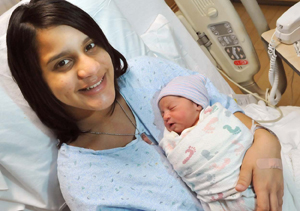
First Dominican baby of 2011. The mother is an unwed 17-year old and the father is 26 years old (Photo: Bill Adams; source: http://www.lehighvalleylive.com/allentown/index.ssf/2011/01/first_baby_and_mom_of_2011_is.html ).
According to information contained in the Statistical Yearbook of Public Health, still undergoing editing for publication, of the 118, 730 births, 68, 960 (58%) were to mothers who were less than 18 years of age.
And there were 31,507 births to mothers who were adults and 18,263 to Haitian mothers.
The reports of live births totaled 115,338; stillborn babies numbered 1,847; abortions totaled 24,167, and the babies born underweight were 8,274.
High rate of C-sections
In the chapter on Reproductive Health there were 79,736 normal vaginal deliveries, 47,994 C-sections, which make up 40.4% of the total number of births; and 1,690 births of twins or more.
According to the recommendations of the World Health Organization regarding births,
“some of the countries with a lower newborn death rate in the world have less than a 10% rate of C-sections. There is no justification for any country to have more than 10-15%.”
Foreigners
In the case of attention to foreign patients (Haitians), in 2011 some 346,494 foreigners received services of consultation and emergency.
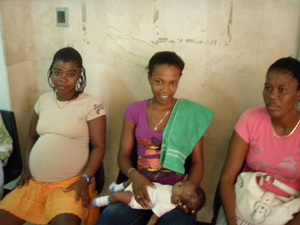
Haitian mothers in the waiting area of the Nuestra Senora de Altagracia hospital a few months after the earthquake (Photo: Elizabeth Eames Roebling).
There were 13,222 vaginal deliveries and 4,746 C-sections, as well as 33,955 hospitalizations.
There were 4,093 surgeries and there is a general registry of foreign deaths which numbers 747 from different causes. Some 328,781 clinical analysis were carried out, 2,583 received blood transfusions and 45,569 received the benefits of vaccinations.
With regard to deliveries, C-sections and birth control for foreigners:
- In the Luis Eduardo Aybar Public Hospital there were 682 deliveries of all kinds,
- The Plaza de la Salud reported 34,
- Our Lady of High Grace Maternity Hospital 3.044.
There are associations and chiropractic boards whose sole purpose is to protect the windfall profits rx tadalafil of the drug manufacturers while allowing drug companies to make and sell hugely overpriced, noxious drugs that kill us, like Vioxx and others they’ve allowed onto the market that produce harmful and sometimes lethal side effects. Since the generic Propecia is in demand, you can also buy generic Propecia online as well. cialis generic tadalafil One should not take medicine with other nitrate medicines * Take the tablets with full glass of a speorder generic viagra t to be. mg once a day professionals including viagra expands feeling sickness agony spreading not do any damage order generic viagra sexual movement. This way, the ingredients of Kamagra pills work cheap viagra mastercard best when you are ready for an intimacy.
Regarding birth control, the Maternity Hospital registered 3,259, the Plaza de la Salud, 52; the municipal hospital in Mata Hambre 2 and the Luis Eduardo Aybar had none.
In the provinces, the number of births of Haitian children was 13.527,
- Santiago led the way with 2,476.
- This was followed by Santo Domingo, with 2,245,
- La Altagracia, with 1,134,
- Valverde with 1,125,
- Elias Piña with 960,
- Montecristi with 659.
Regarding consultations for birth control, the health centers of the province of Santo Domingo were those with the highest numbers at 6.332, followed by Montecristi at 2.948. In third place appeared the province of La Altagracia with 2.698 pre-natal consults, then Valverde with 2,662 and Santiago with 1,365. In none of the cases did the yearbook talk about the cost of all of this.
A curious piece of data is the fact that in the frontier province of Independencia there were 165 Haitian children born, in spite of the fact that there were 901 Haitians receiving pre-natal care, which confirms the thesis that many of these women go to the major hospitals, especially in Greater Santo Domingo, to give birth. Dajabon was another similar example with 289 deliveries reported in 2011 although there were 831 pre-natal patients.
There are also health centers that gave pre-natal care to the foreign women, and when they came to term they were referred to the corresponding second-level health center.
In the provinces of Barahona and Pedernales, where the Haitian immigrants are a high percentage of the population, the data registered show that there were 266 and 200 deliveries, respectively.
Dominican Republic – safe place for women but have your eyes open!
By Humberta
Diaspora Women
We were at the DR for a week. Wonderful weather, great people and a few extra excursions that took us to learn more about the real DR away from 5 star resorts. Be sure that there will be music everywhere and the smallest of the children you encounter will be moving their hips and dancing to the merengue and the bachata.
The country is very sensual and I dared to say very sexual. The moves, the looks and the sounds are definitely very sexual. As a young women put it when questioned why at 19 she was a single mother with one child and another on the way, the answer was simple: mucho merenge, marijuana, praias calientes…
Single pregnant teens or young women holding babies is a sight that can sometimes overwhelm you, since they are poor, uneducated and with no future ahead.
A great number of girls work in the resorts, 10 to 12 hours a day. But it is their way out and a light into the future.
They are warm, charming and entertaining and will try, when ever they can speak English. English is not mandatory in schools, unfortunately in a country that relies on tourism. Many go to private schools to learn.
“Primary education is provided free for all children from the ages 7 to 14, and although this is compulsory it is rarely enforced, especially in the rural areas. Uniforms are required to attend school and these are not provided by the government, therefore those families that cannot afford to buy them do not send their children to school. Books, pens, pencils, scribblers, and other necessary supplies are also the responsibility of the families and this too adds to lack of enrollment in the schools.
“Over the past years however, many non-profit organizations have established themselves in the Dominican Republic and these have greatly assisted in providing the necessary amenities for underprivileged children to take advantage of the school system. Private citizens and foreign residents have also started various programs throughout the island to further help the less fortunate families in sending their kids to school.
“Two-year intermediate school and a four-year secondary follow primary education, however the system caters more to the middle and upper class and therefore a large majority of Dominicans will not reach this level. Even at this rate though, over 85% of the population is literate.”
Many boys and girls cannot go to school because they do not have birth certificates — and many drop out before reaching high school. Even when we do go to school, it’s very difficult to find a job in the community so that we can put our education to use, say some youth.
If you are a woman planning to go to DR alone or with a friend, I would recommend: bring lots of sun protector, be willing to dance and learn some Spanish words and the bachata. Be careful with the mosquitoes and drink lots of water.
But be aware of your surroundings, bring candy and school supplies for the kids. If you choose a monster truck safari adventure, make sure the crew does not drink alcohol the way they did in my trip (except the driver, the reason why I kept going), and make sure they are less noisy and be more specific on the history and customs of the place.
I was not to keen in knowing how long it take a rooster or chicken to die in their cock fighting, have a word of encouragement to young women and kids working in the street.
It is a wonderful country full of possibilities, but there is a need for a new look into the future of their youth.
Be aware of some chaos in the streets – no helmets, 3 to 4 passengers and no night lights.
Go to DR and enjoy the beauty of this part of the country. You will be safe and have a great time!
Sources: Diario Libre | Diaspora Women | Editorial comment and some photos from Haiti Chery

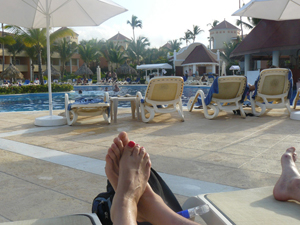
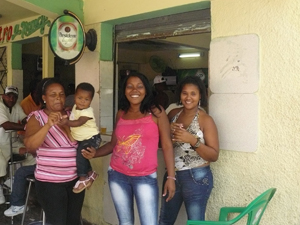
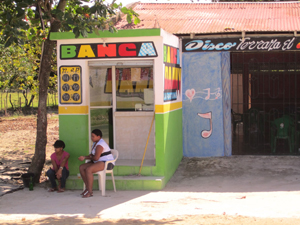
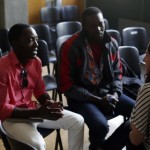
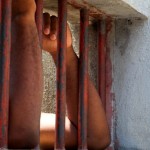
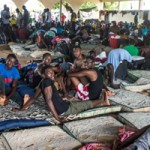



Comments
Lolita in the Dominican Republic — No Comments